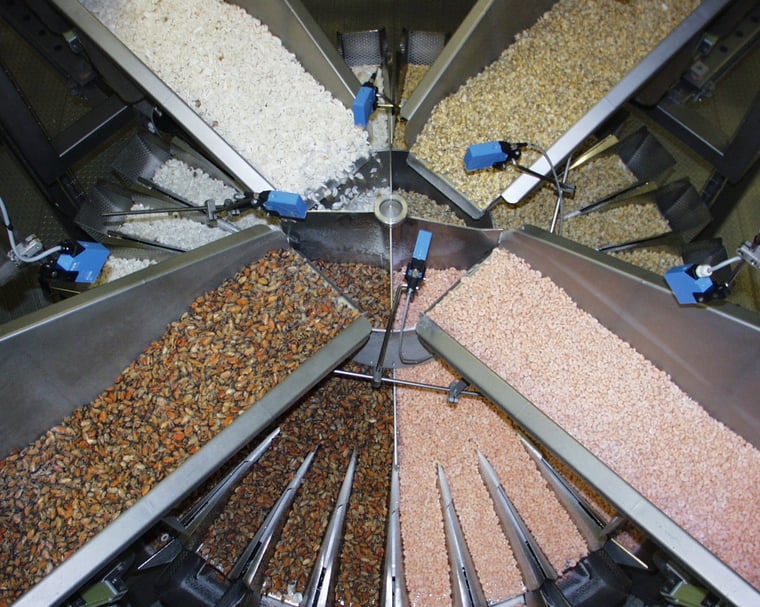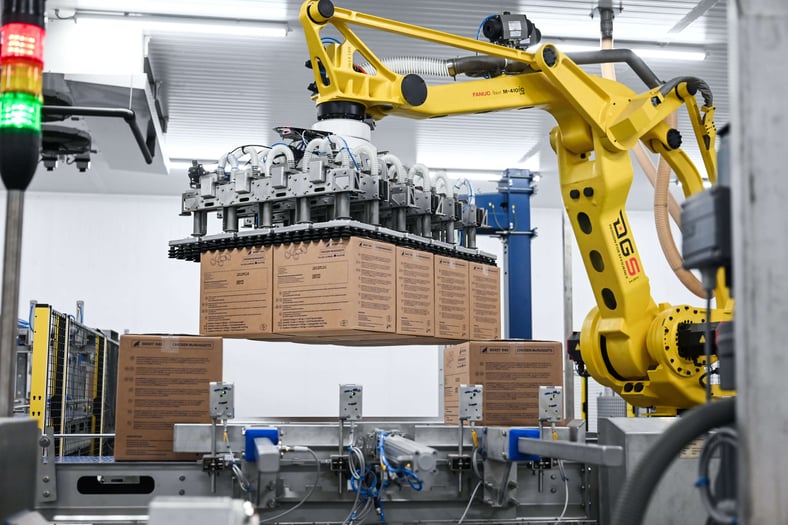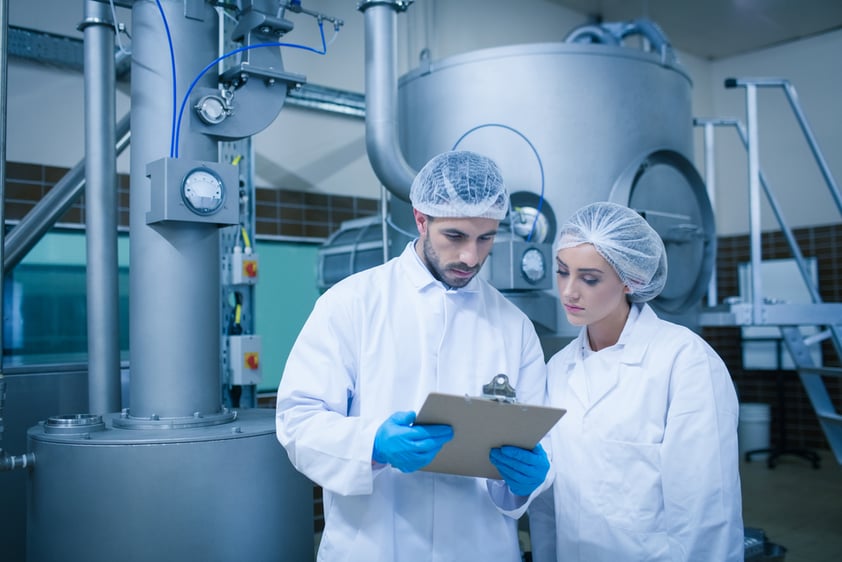In the dynamic landscape of the food processing industry, the debate between automation and manual labor has always been a critical consideration for businesses. The industry has witnessed significant changes over the years. In the past, manual labor played a central role in tasks such as sorting, cutting, packaging, and quality control. While manual labor allowed for a degree of customization and adaptability, it came with challenges such as high labor costs, inconsistencies in product quality, and safety concerns.
The advent of automation in the food processing industry began in the mid-20th century. Early automation systems introduced conveyor belts, mechanical sorters, and basic packaging machinery. These innovations led to increased efficiency, reduced labor costs, and improved product consistency. However, they were often expensive to implement and required skilled technicians to maintain.
 A Cabinplant Multihead Weigher weighing four different products to weigh and create exact mixes of the products
A Cabinplant Multihead Weigher weighing four different products to weigh and create exact mixes of the products
Today, the food processing industry relies heavily on automation. Modern factories employ advanced technologies, including robotics, artificial intelligence, and IoT devices, to handle various tasks such as sorting, cooking, and packaging. Automation has led to higher production rates, improved safety, reduced labor expenses, and enhanced product quality. Automation can offer several advantages over human labour in certain situations and industries. However, it's important to note that the superiority of automation versus human labour depends on the specific context and the goals of a particular task or process. Here are some reasons why automation can be considered better than human labour in certain scenarios:
- Efficiency and Speed - Automation can perform repetitive tasks without fatigue or breaks, leading to consistent and high-speed operations. They can work 24/7, ensuring continuous production and minimizing downtime.
- Precision and Accuracy - Machines and robots can achieve a level of precision and accuracy that is difficult for humans to match, reducing errors and waste in manufacturing and other processes.
- Safety - Automation can be used in hazardous environments or situations where it may be unsafe for humans to work, such as handling toxic chemicals or working in extreme temperatures.
- Cost Reduction - Once the initial setup costs are absorbed, automation can be cost-effective in the long run, as it eliminates ongoing labour costs, reduces the risk of human error, and increases productivity.
- Scalability - Automated systems can be easily scaled up or down to meet changing production demands, making them adaptable to market fluctuations.
- Consistency - Automation ensures consistent quality in production, as machines and robots follow predefined instructions without variation.
- Data Collection and Analysis - Automation can collect and analyse vast amounts of data in real-time, providing valuable insights for process optimization and decision-making.
- Repetitive Tasks - Humans are often better suited for creative, problem-solving, and decision-making tasks, while automation is ideal for repetitive and routine tasks that may be monotonous or dull for human workers.
- Increased Productivity - Automated systems can complete tasks faster and with fewer errors, leading to increased overall productivity.
- Health & Safety: Automation can also help improve worker safety by performing dangerous tasks or working in hazardous environments, thereby reducing the risk of accidents and improving overall workplace safety.
However, it's important to consider the potential drawbacks of automation as well, such as high initial setup costs, job displacement, and the need for maintenance and technical expertise. Additionally, not all tasks or industries are suitable for full automation, and there are instances where the human touch, creativity, and problem-solving abilities remain indispensable. Ultimately, the decision to use automation versus human labor should be made based on a careful analysis of the specific circumstances and goals of the task or process in question.
It's important to note that the choice isn't necessarily binary - automation versus manual labour. In many cases, a combination of both can lead to optimal results. For instance, automating repetitive or hazardous tasks while retaining human workers for jobs that require skill, judgment, or flexibility, are commonly referred to as "cobotics" (collaborative robotics).
 DGS automation robot for case and pallet packing
DGS automation robot for case and pallet packing
Determining whether to invest in automation or continue relying on manual labor requires a careful analysis of the ROI for the business. Some of the factors that need to be considered to find out the ROI are:
- Cost Analysis: Start by comparing the costs associated with automation and human labor. Consider factors like initial setup costs, maintenance expenses, labor wages, and benefits.
- Productivity Gains: Estimate the increase in productivity that automation can provide compared to manual labor. This could be in terms of production speed, reduced errors, or extended operating hours.
- Quality Improvement: Assess how automation can enhance product quality, leading to potential savings by reducing waste or product recalls.
- Scalability: Evaluate whether automation can easily adapt to changes in production volume or product variety without significant reconfiguration costs.
- Longevity: Consider the expected lifespan of automation equipment and compare it to the long-term labor costs.
- Risk and Safety: Assess the impact of automation on workplace safety and the reduction of risks associated with manual labor.
- Market Trends: Research industry trends and consumer demands to determine if automation aligns with market expectations.
Is Automation the Right Call for Your Business?
Making the decision to automate or continue with manual labor is not always straightforward. At Sealpac UK, we work with our customers to create the best personalised solutions for their requirements. Some of the key points most of our clients consider along with our help, before choosing their solution are:
- Economic Viability: Calculate the ROI carefully to ensure that automation is financially viable for your specific situation.
- Flexibility: Assess the degree of flexibility required in your production processes. Some industries or products may benefit more from automation, while others require human adaptability.
- Skill Availability: Consider the availability of skilled technicians to operate and maintain automated systems.
- Regulatory Compliance: Ensure that your automation processes align with industry regulations and safety standards.
- Market Demand: Monitor market trends and customer preferences to adapt your production methods accordingly.
- Gradual Transition: It's often wise to implement automation gradually, allowing for adjustment and optimization over time.
The food processing industry has come a long way from its reliance on manual labor to embrace automation as a key driver of efficiency and quality. Ultimately, the choice between automation and manual labor should align with your business's specific needs, goals, and long-term strategy, taking into account the past, present, and future of the industry.
Discover the inspiring stories of how Sealpac UK partnered with diverse businesses, crafting tailor-made solutions to conquer their unique obstacles.
